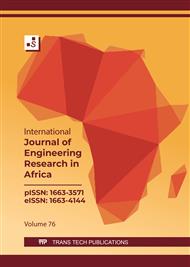[1]
Z. Liu and X. Liu, "Review of HVDC transmission technologies and applications," Renewable and Sustainable Energy Reviews, vol. 50, pp.41-52, 2015.
Google Scholar
[2]
D. Jovcic and O. Marjanovic, "High voltage direct current (HVDC) transmission systems technology review paper," Energy, vol. 122, pp.1051-1061, 2016.
Google Scholar
[3]
K. R. Padiyar, HVDC Power Transmission Systems, 3rd ed. New Delhi, India: New Age International Publishers, 2017.
Google Scholar
[4]
A.M. Alsseid, D. Jovcic, and A. Starkey, "Small signal modeling and stability analysis of multi-terminal VSC-HVDC," in Proc. 2011 14th European Conf. Power Electron. and Appl., 2011, pp.1-10.
Google Scholar
[5]
P. Kundur, Power System Stability and Control, McGraw-Hill, 1994.
Google Scholar
[6]
N. G. Hingorani and L. Gyugyi, Understanding FACTS: Concepts and Technology of Flexible AC Transmission Systems. New York, NY, USA: IEEE Press, 2000.
Google Scholar
[7]
S. Arabi, G. Rogers, D. Y. Wong, P. Kundur, and M. G. Lauby, "Small signal stability program analysis of SVC and HVDC in AC power systems," IEEE Trans. Power Syst., vol. 6, no. 3, pp.1147-1153, Aug. 1991.
DOI: 10.1109/59.119259
Google Scholar
[8]
C. M. Osauskas and A. Wood, "Small Signal Dynamic Modeling of HVdc Systems," IEEE Power Eng. Rev., vol. 22, no. 12, pp.62-63, Dec. 2002.
DOI: 10.1109/MPER.2002.4312430
Google Scholar
[9]
G. Goran., D. Marko., and B. Jef. Comparative Analysis on Small-Signal Stability of a Multi-Infeed VSC HVDC System with Different Reactive Power Control Strategies. IEEE Access. (2019).
DOI: 10.1109/access.2019.2948290
Google Scholar
[10]
A. Mohammad., M. Martu., L. Jing., and C. Xu. Impact of Power Flow Direction on the Stability of VSC-HVDC seen from the Impedances Nyquist Plot. IEEE Transaction on Power Electronics. (2016).
DOI: 10.1109/tpel.2016.2608278
Google Scholar
[11]
P. Mitra, L. Zhang, and L. Harnefors. Offshore Wind Integration to a Weak Grid by VSC-HVDC Links Using Power-Synchronization Control: A Case Study. IEEE Trans. Power Deliv., vol. 29, no. 1, (2014) pp.453-461
DOI: 10.1109/tpwrd.2013.2273979
Google Scholar
[12]
L. Huang, H. Xin, H. Yang, Z. Wang, and H. Xie. Interconnecting Very Weak AC Systems by Multi-terminal VSC-HVDC Links with a Unified Virtual Synchronous Control. IEEE J. Emerg. Sel. Top. Power Electron., vol. 6, no. 2, (2018) pp.1041-1053.
DOI: 10.1109/jestpe.2018.2825391
Google Scholar
[13]
M. Ndreko, J. L. Rueda, M. Popov, and M. A. M. M. van der Meijden. Optimal fault ride through compliance of offshore wind power plants with VSC-HVDC connection by meta-heuristic based tuning. Electr. Power Syst. Res., vol. 145,(2017) pp.99-111.
DOI: 10.1016/j.epsr.2016.12.024
Google Scholar
[14]
G. Chunyi., L. Wei., Z. Jian., and Z. Chengyong. Impact of Control System on Small-Signal Stability of Hybrid Multi-Infeed HVDC system. IET Generation, Transmission & Distribution, (2018).
DOI: 10.1049/iet-gtd.2018.5087
Google Scholar
[15]
C.B. Tambwe., and R.P. Carpanen. Damping Sub-synchronous Oscillations Using a High Voltage Direct Current-Based Multi-Modal Damping Controller. International Journal of Engineering Research in Africa, (2022) pp.133-160.
DOI: 10.4028/p-530sb3
Google Scholar
[16]
H. Fang., J. Zhou., H. Liu., Y. Wang., H. Xiang., and Y. Xin. Analysis of Additional Damping Control Strategy and Parameter Optimization for Improving Small Signal Stability of VSC-HVDC System. Energy Engineering, (2023) pp.931-948.
DOI: 10.32604/ee.2023.025163
Google Scholar
[17]
J. Renedo., L. Rouco., A. Garcia-Cerrada., and L. Sigrist. Coordinated control in multi-terminal VSC-HVDC systems to improve transient stability: Impact on electromechanical-oscillation damping, IEEE Transactions on Power Systems, vol. 37, (2022) pp.3091-3102.
DOI: 10.22541/au.166696720.08012744/v1
Google Scholar
[18]
Y. He., X. Zhao., and M. Wang. Design of HVDC Supplementary Controller Based on Extension Control Strategy. In 2016 International Conference on Civil, Transportation and Environment, (2016) pp.784-787
DOI: 10.2991/iccte-16.2016.134
Google Scholar
[19]
Y. Shao., and Y. Tang. Voltage stability analysis of multi-infeed HVDC systems using small-signal stability assessment. IEEE, (2010) pp.1-6.
DOI: 10.1109/tdc.2010.5484473
Google Scholar
[20]
O.E., Oni., A.G. Swanson., and R.P. Carpanen. Small signal stability analysis of a four-machine system with placement of multi-terminal high voltage direct current link. Journal of Energy in Southern Africa, (2020) pp.73-87.
DOI: 10.17159/2413-3051/2020/v31i1a7430
Google Scholar
[21]
Y. Zhou et al. Dynamic modeling and analysis of a two-area four-machine system. IEEE Transactions on Power Systems, (2018) pp.6392-6401.
Google Scholar
[22]
CIGRÉ Working Group B4.57. Benchmarking of Control Strategies for Synchronous Generators. CIGRÉ Technical Brochure, 2014.
Google Scholar
[23]
O.E. Oni., A.G. Swanson., R.P. Carpanen, and A. Aluko. Implementation of a Multi-terminal Line Commutated Converter HVDC Scheme with Auxiliary Controller on South Africa's 765 kV Corridor. Energies, (2022) pp.34-45
DOI: 10.3390/en15124356
Google Scholar
[24]
O.E. Oni., A.G. Swanson., and R.P. Carpanen. Line Commutated Converter Response during Total and Partial De-Blocking of a Bipolar MTDC System. International Journal of Engineering Research in Africa, (2021) pp.49-61.
DOI: 10.4028/www.scientific.net/jera.52.49
Google Scholar


